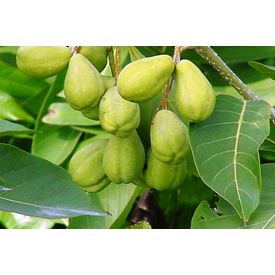Description
Terminalia chebula- Yellow Myrobalan or Chebulic Myrobalan; Sinhala: Aralu, Tamil:Kadukkai;Assamese: Xilikha; Gujarati: Himmej; Telugu: Karakkaya; Sanskrit: harītakī, Bangla: harītakī; Tibetan: A-ru-ra is a species of Terminalia, native to southern Asia from India and Nepal east to southwestern China, and south to Sri Lanka, Malaysia and Vietnam.
It is a deciduous tree growing to 30-metre (98 ft) tall, with a trunk up to 1-metre (3 ft 3 in) in diameter. The leaves are alternate to subopposite in arrangement.
This tree yields smallish, ribbed and nut-like fruits which are picked when still green and then pickled, boiled with a little added sugarin their own syrup or used in preserves.
The seed of the fruit, which has an elliptical shape, is an abrasive seed enveloped by a fleshy and firm pulp. It is regarded as a universal panacea in the Ayur-Vedic Medicine and in the Traditional Tibetan medicine. It is reputed to cure blindness and it is believed to inhibit the growth of malignant tumours.
The dry nut's peel is used to cure cold-related nagging coughs. The bark/peel of the nut is placed in the cheek. Although the material does not dissolve, the resulting saliva, bitter in taste, is believed to have medicinal qualities to cure cold related coughs. Its fruit has digestive, anti-inflammatory, anthelmintic, cardiotonic, aphrodisiac and restorative properties and is additionally beneficial in flatulence, constipation, piles, cough and colds.
Source : Wikipedia




